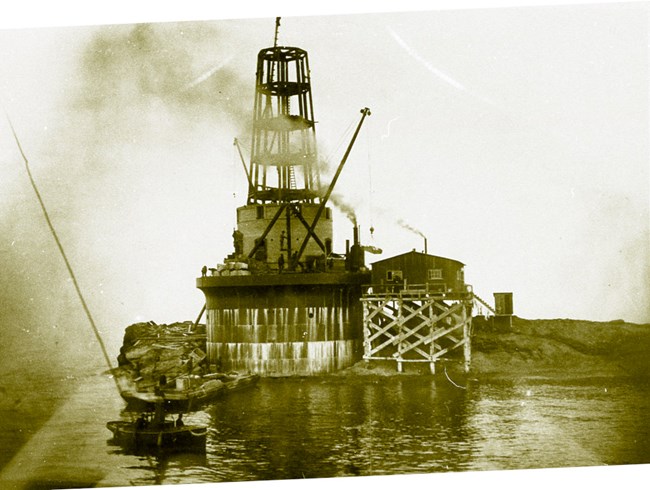Last updated: September 24, 2020
Article
Rock of Ages Lighthouse

Isle Royale National Park Archives
Summary
Just outside Washington Harbor stands the Rock of Ages Light, which began operation in 1908. The 117-foot white cylinder-shaped lighthouse is composed of steel, concrete, and brick, with a black base and lantern. To build this lighthouse on a 50-foot by 200-foot rocky outcrop was a tribute to the engineering of the time. In 1909, a Second Order Fresnel lens replaced the first, temporary Third Order fixed red light. Today, the unmanned lighthouse features a 300 mm Tideland Signal Acrylic Optic lens that runs on solar power. You can view the stunning old Second Order Fresnel lens at the Windigo Visitor Center.
History
Situated five miles off the northwest tip of Isle Royale in Lake Superior, Rock of Ages Lighthouse stands as one of the tallest and most powerful beacons on the Great Lakes. The steel frame and brick masonry tower was completed in 1908. It rests on a 50' diameter steel crib filled with concrete and anchored to a narrow rock outcropping. The Rock of Ages reef had claimed two sizable ships, the Cumberland (1877) and the Henry Chisholm (1898), and posed a threat to many other large vessels along the active shipping lane between Port Arthur (Thunder Bay) and Duluth.
The Lighthouse Board first recommended to the U.S. Congress that a light tower be built on the reef in 1896. In 1905, $25,000 was appropriated for a site survey and planning. Captain Charles Keller of the U.S. Corps of Engineers designed the light tower with a two-story cylindrical base 25' in diameter and a four-story conical section that tapered to 17' at the base of the lantern section. Construction was carried out by Walter F. Beyer of Detroit. The erection of the 130' tower on the remote reef was considered an engineering feat in its day, comparable to the light towers built on Spectacle Reef in Lake Huron (1874) and Stannard Rock (1882). The total construction cost was $125,000. A temporary third-order fixed red light was illuminated on October 11, 1908.
Construction of the crib began in May, 1907. The Lighthouse Board leased the Washington Club at Washington Harbor, Isle Royale, for the initial work of the section of the crib. The massive steel plates were riveted together on site and tied back to the concrete fill with anchor rods. The crib rose 30' above mean water level with a deck that enlarged to 56' in diameter. The tower was composed of a steel skeletal framework with brick inner and outer walls and exterior concrete parging with a buff-colored finish. Decorative moldings and pilasters emphasized the second level of the base. All windows and the main door had cast-iron casings and shutters painted black. The first-order wrought-iron and bronze lantern and service room were pre-manufactured and assembled on site with ornamental cast-iron brackets lending a more visual support to the wrought-iron gallery that surrounded the service room. All exterior surfaces were painted black. Work was completed by the end of the fiscal year 1908.
In 1909, an additional $15,000 was appropriated for the installation of a second-order Fresnel lens. The lenticular lens was made to order by Barbier, Bernard and Turenne of Paris and was first lit on September 15, 1910. The lens is composed of four panels with hundreds of concentrically arranged prisms about four bull's-eyes and fitted into brass frames. The 9' tall lens floated on a bed of mercury atop a cast-iron pedestal. It was driven by brass clockwork and rotated once every 20 seconds, producing a pair of double white flashes with an intensity of 940,000 candlepower each. The light was furnished by a 55-millimeter double-tank incandescent oil-vapor lamp which burned kerosene. The focal plane was 117' above mean water level with a range of 29 miles on a clear night which made it the most powerful beacon on the Great Lakes.
A four-member crew served the lighthouse until 1977. They lived within the ten levels of the tower. The crib contained two basement levels which housed water tanks and a boiler that supplied steam heat through a pipe and radiator system to the levels above. The two-story base of the tower housed the entry level with decorative interior pilasters and tile wainscot containing the fog-signal plant and hoisting engine for a pillar crane. The 6-ton iron and steel pillar crane was located on the deck directly above the concrete boat landing with a cable tunnel into the first basement level and a pulley that routed the cable through the floor to the hoisting engine above. The four-story conical section housed an office at the third level, sleeping quarters at the fourth and fifth levels and a watch room at the sixth level. All interior walls had a plaster finish with wood baseboard, door and window trims. Closets and cabinets were fitted into either side of the clay-tile stairwells. The two-story lantern section capped the tower. Fuel tanks, a 16' sailboat and a 16' clinker rowboat were located on the deck.
The light tower was resurfaced and whitewashed ca. 1975. The second level moldings and pilasters were smoothed over giving it the spark plug shape it has today. A modern fog signal, located on the deck, replaced the fog-signal plant. The Fresnel lens and cast-iron pedestal were removed in 1985 and put on display at the Windigo Visitors' center on Isle Royale. A much smaller acrylic lens with a solar-powered light serves as the beacon today.
The Rock of Ages Lighthouse is one of the most unique beacons on the Great Lakes. It is one of four lighthouses that have served Isle Royale and its immediate vicinity. Although shipping has decreased between Port Arthur and Duluth, the reef remains a focal point for small fishing vessels and divers exploring the wrecks below.
Quick Facts
| Attributes | Data |
|---|
